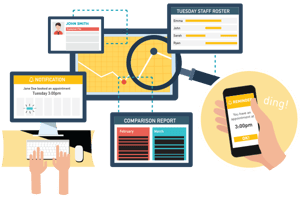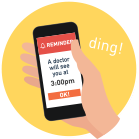Everything you need to know
Contents
Here, we outline what exactly a queue management system is, how it works and why you need it, in short, digestible chunks. You can read our guide from top to bottom, or skip to a point that is most relevant for your needs.
 When we think of a queue, we automatically picture a long line of people – probably checking their watches and tapping their toes in annoyance. Put simply, a queue is a line of people awaiting services or products – where demand has exceeded supply. Let’s look at the different types of queues you can get before explaining how to manage them.
When we think of a queue, we automatically picture a long line of people – probably checking their watches and tapping their toes in annoyance. Put simply, a queue is a line of people awaiting services or products – where demand has exceeded supply. Let’s look at the different types of queues you can get before explaining how to manage them.
• Structured queues. These are where people form a queue in a fixed, predictable position, like at a supermarket checkout or at airport security.
• Unstructured queues. Where people form a queue in unpredictable and varying locations and direction, like in retail or at ATMS. Physical barriers may be used to funnel people into a line.
• Kiosk based queues. Used by banks, and medical and government service locations, these are where people enter basic information into a kiosk about themselves and their reason for their visit.
• Mobile queue. Customers use an app on their mobile phone to make an appointment and check in, meaning they don’t have to be at the service centre until their appointment time.
Just as there are different types of queues, so to are there different ways of managing them:
• Physical barrier. Using bollards and belts
• Digital signage. Customers enter their information into an LCD screen upon arrival and then watch the TV screens to see when their number is called up. The TV screens can also display advertising and stream live TV or music to entertain customers while they wait.
• Appointment scheduling. Customers can use an app on their phone to make the appointment, fill their details in and even check in to the service when they arrive.
Queue management is there to streamline customer service and create a better operating environment for staff. Read more here.
 A queue management system is a set of principles aimed at controlling customer flow and streamlining the queuing experience.
A queue management system is a set of principles aimed at controlling customer flow and streamlining the queuing experience.
It is a technological solution designed to manage and analyse the customer interactions in a service centre.
A QMS will analyse and manage:
These aspects are difficult to monitor manually, but an effective QMS can ensure that the waiting process is orderly with the technology there to allow for a smooth and efficient experience.
A good queue management system should have the following attributes:
Read more about Queue management systems here.
Now that we know what a queue management system is, let’s explore the different types you get.
Physical Management
Actual belt barriers or bollards that limit where people stand, like in cinemas. These can cause stress because people can feel trapped and are also very aware of how long they will have to wait. It is not an effective queue management system.
Sign-in sheet
Visitors fill out a form and hand it in to the receptionist. Handwriting is not always legible and it is time-consuming.
Ticket-based management
Visitors take a number and wait until the screen displays their number.
Sometimes ticket stands can run out of paper at a critical moment. They’re also very impersonal.
Digital management
Visitors enter their own data onto a touch screen and it is then customised. The only issue with this system is that it’s quite new and people are still getting used to it. They may also be expensive in the short term, but the value is long lasting.
Human management
A personal server guides the customer through every step of the service.This would be fantastic but very expensive. Organisations could try to include human management to work in tandem with any of the other types of queue management systems mentioned above.
It’s virtually impossible to list the benefits of a QMS for your organisation – but we’ll try. Here we’ve boiled them down to five crucial ones:
Reduce long lines.
A QMS will give your customers quicker access to the services they need, which will shorten their wait times and reduce congestion. In turn, this improves customer satisfaction and has the added bonus of them not walking away in frustration because they’ve been waiting too long!
Enhanced customer experience
A queue management system ensures customers are waiting in the right line, how long they will be waiting for and can entertain them while they wait. If people are kept busy they won’t be thinking about how long they’ve been waiting for.
Free up staff to perform better
If staff aren’t having to manage long lines they can focus on serving customers. This benefits both the employees and the customers in the long run.
Provide useful data
A QMS gathers real-time data about the service, the wait time and the customers. This data can be used to work out which areas are working well and which ones need improving.
Increase your bottom line
Enhancing your organisations efficiencies will save you time, reduce costs and improve customer engagement to the point where they turn into repeat customers.
For Visitors
Visitors don’t want to be mucked around. They want to feel valued, without any stress. For visitors, a QMS will:
For Managers
A QMS will help to keep chaos at bay in your organisation by:
For Administration
The customer experience and business image is hugely dependent on how long customers are waiting so a QMS helps by:
A virtual queue, also known as electronic queue management or ticketing queue system, is used in environments where queues are formed in unpredictable and varying locations. There are different types of virtual queues:
 Ticketed - A customer takes a ticket upon entry. Your number is placed in a virtual queue and comes up on a screen when a desk has become available. Benefits include being able to streamline the type of service you’re there for, and you should be able to sit and wait until you’re called.
Ticketed - A customer takes a ticket upon entry. Your number is placed in a virtual queue and comes up on a screen when a desk has become available. Benefits include being able to streamline the type of service you’re there for, and you should be able to sit and wait until you’re called.
 Data entry - The customer registers their information themselves on a touch screen and can customise what service they’re after. This will personalise the service and reduce wait times.
Data entry - The customer registers their information themselves on a touch screen and can customise what service they’re after. This will personalise the service and reduce wait times.
 Telephone call back - Many call centres manage a high influx of calls by using a virtual queuing system that gives people the option to hang up and let the system maintain their place in the queue.
Telephone call back - Many call centres manage a high influx of calls by using a virtual queuing system that gives people the option to hang up and let the system maintain their place in the queue.

Online check in - Checking in online or using an app means customers can wait anywhere.
Using a digital queue instead of a physical one means customers have the freedom to sit while they wait or even go out and do some chores until they are summoned to approach a desk. It takes the stress out of waiting. Read more about virtual queues here.
 All you need to turn an impatient queue into a relaxed waiting environment is the right accessible technology. And what better technology to use than one that people are already carrying around with them in their pockets and handbags? Their mobile phones.
All you need to turn an impatient queue into a relaxed waiting environment is the right accessible technology. And what better technology to use than one that people are already carrying around with them in their pockets and handbags? Their mobile phones.
A queue management app will allow customers to check in to your service from home. They can also connect to your organisation’s kiosk for dual-overhead queue management.
A simple queue management app is better than tickets and sign in sheets for a number of reasons. Read more about how a queue management app can improve your customer experience here.
Using technology already in your customer’s pockets has a myriad of benefits. A simple queue management app can improve your customer experiences by:
If your business has been seeing problems with long wait times and agitated customers, using a queue management app can transform the wait experience and make the entire process more convenient for both customers and your staff who work hard to provide a good service.
 Do you know how many people are standing in your waiting lines at any given moment? How long will they be waiting? How long is too long? At what point are your queues hurting your service experience and resulting in dissatisfied customers?
Do you know how many people are standing in your waiting lines at any given moment? How long will they be waiting? How long is too long? At what point are your queues hurting your service experience and resulting in dissatisfied customers?
The answers to these questions are important to service centre managers because customers despise waiting in queues and unhappy customers can have a lasting negative effect on your organisation.
In a recent study, 95% of respondents said they usually tell at least one other person about a bad customer experience.
So how do you get answers to those questions above? Implementing a queue management system will provide you with all the information you need so you can make informed decisions that will benefit your customers, staff and bottom line.
With real-time data for performance indicators such as customer counts, wait times, traffic trends, service point utilisation, arrival rates and service rates and times, organisations are empowered to make informed decisions on how best to serve customers.
This real-time data will improve both front-end and back-end operations.
Nexa’s queue management solution can be tailored to meet your simple or complex needs. Nexa has a suite of tools to help manage and analyse the flow of customers in your service centre and optimise your customer experience.
Nexa’s Queue Management Tools for efficient customer flow include:
Whether you have patients, students, rate payers or customers waiting in your service centre, we can help make every interaction matter. Contact us today to find out more.
Improve the customer experience, with real data. NEXA is an Australian company that delivers innovative solutions to streamline the customer journey.
FOLLOW US ON LinkedIn
+61 (02) 8383 3800
sales@nexa.com.au
NEXA Group Pty Ltd
Level 6, 1 Newland Street,
Bondi Junction 2022
NSW Australia